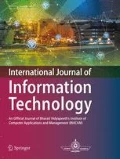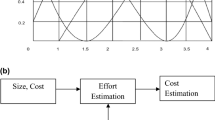Abstract
Software cost estimation SCE is directly related to quality of software. The paper presents a hybrid approach that is an amalgamation of algorithmic (parametric models) and non-algorithmic (expert estimation) models. Algorithmic model uses COCOMO II while non algorithmic utilizes Neuro-Fuzzy technique that can be further used to estimate accuracy in irregular functions. For generalization of the model, Neuro-fuzzy membership functions have been used and simulated using mathematical tool MATLAB. Also, the proposed model has been validated with traditional COCOMO model (COCOMO 81) by using NASA software project data. The experimental results suggest that the proposed model gives better SCE as compared to its traditional counterpart.






Similar content being viewed by others
References
Boehm B et al (2000) Software cost estimation with COCOMO II. Prentice Hall PTR, New Jersey, p 07458
Boehm B (1981) Software engineering economics. Prentice- Hall Inc, New Jersey, p 07632
MacDonell S, Gray A (1997) A comparison of modeling techniques for software development effort prediction. In: proceedings of the 1997 International Conference on Neural Information Processing and Intelligent Information Systems, Springer-Verlag. 869–872
Chulani S (1999) Bayesian analysis of software cost and quality models, Ph.D. Dissertation, University of Southern California
Standish Report-1998, 1999, 2000, Chaos Report
Cai KY, Wen CY, Zhang ML (1991) A critical review on software reliability modeling. Reliab Engi Syst Saf 32(3):357–371
Karunanithi N, Whitley D, Maliya YK (1992) Prediction of software reliability using connectionist models. IEEE Trans Softw Eng 18:563–574
Sitte R (1999) Comparison of software-reliability-growth predictions: neural networks vs parametric recalibration. IEEE Trans Reliab 48(3):285–291
Tian L, Noore A (2005) Evolutionary neural network modeling for software cumulative failure time prediction. Reliab Eng Syst Saf 87:45–51
Su Y-S, Huang C-Y (2006) Neural-network-based approaches for software reliability estimation using dynamic weighted combinational models. J Syst Softw 80(4):606–615
Madsen H, Thyregod P, Burtschy B, Albeanu G, Popentiu F (2006) On using soft computing techniques in software reliability engineering. Int J Reliab Qual Saf Eng 13(1):61–72
Kumar R, Grover PS, Kumar A (2010) A fuzzy logic approach to measure complexity of generic aspect-oriented systems. J Object Technol 9(3):43–57
Wason R, Ahmed P, Rafiq MQ (2013) A tool for runtime reliability estimation and control using automata-based software reliability model. In Proceedings of the second WSEAS International Conference on Computers, Digital Communications and Computing (ICDCC 2013). 51–56
Aggarwal KK, Singh Y, Chandra P, Puri M (2005) Evaluation of various training algorithm in a neural network model for software engineering application. ACMSIGSOFT Softw Eng Notes 30(4):1–4
Aggarwal KK, Singh Y, Chandra P, Puri M (2005) Measurement of software maintainability using a fuzzy model. J Comp Sci 1(4):538–542
Yang B, Yao L, Huang H (2007) Early software quality prediction based on a fuzzy neural network model, Third International Conference on Natural Computation (ICNC 2007), IEEE 1: 760–764
Center for Software Engineering (1997) “COCOMO II Model Definition Manual,” Computer Science Department, University of Southern California, Los Angeles, Ca. 90089. http://csse.usc.edu/csse/research/cocomoii/cocomo2000.0/cii_modelman2000.0.pdf. Accessed 13 Apr 2000
Khoshgaftaar TM, Allen ED, Hudepohl JP, Aid SJ (1997) Application of neural networks to software quality modeling of a very large telecommunications system. IEEE Trans Neural Netw 8(4):902–909
Narula Gagandeep Singh, Jain Vishal (2013) Implementation of data mining in online shopping system using TANAGRA tool. Int J Comp Sci Eng 2(1):47–58 (ISSN 2278–9960)
Sheta AF (2006) Estimation of the COCOMO model parameters using genetic algorithms for NASA software project. J Comp Sci 2(2):118–123
Shivakumar et al (2016) A neuro fuzzy algorithm to compute software effort estimation. Glob J Comp Sci Technol C Soft Data Eng 16(1), ISSN 0975-4172
Saka et al (2016) “Modeling software effort estimation using hybrid PSO-ANFIS”, Intelligent Technology and its applications (ISTIA) IEEE. 28–30. https://doi.org/10.1109/isitia.2016.7828661
Author information
Authors and Affiliations
Corresponding author
Appendix A
Appendix A
Costar cost drivers
Personnel factors | COCOMO II post architecture | COCOMO 81, COCOMO 85 | |
|---|---|---|---|
ACAP | Analyst capability | Yes | Yes |
APEX | Applications experience | Yes | Yes |
AEXP | |||
PCAP | Programmer capability | Yes | Yes |
LEXP | Programming language experience | Yes | |
VEXP | Virtual machine experience | Yes | |
PERS | Personnel capability | ||
LTEX | Language and tool experience | Yes | |
Product factors | |||
RELY | Required software reliability | Yes | Yes |
DATA | Database size | Yes | Yes |
CPLX | Software product complexity | Yes | Yes |
RUSE | Required reusability | Yes | |
Platform factors | |||
TIME | Execution time constraint | Yes | Yes |
STOR | Main storage constraint | Yes | Yes |
VIRT | Virtual machine volatility | Yes | |
PVOL | Platform volatility | Yes | |
PDIF | Platform difficulty | ||
Project factors | |||
TOOL | Use of software tools | Yes | Yes |
FCIL | Facilities | ||
RVOL | Requirements volatility | ||
Rights and permissions
About this article
Cite this article
Kaur, I., Narula, G.S., Wason, R. et al. Neuro fuzzy—COCOMO II model for software cost estimation. Int. j. inf. tecnol. 10, 181–187 (2018). https://doi.org/10.1007/s41870-018-0083-6
Received:
Accepted:
Published:
Issue Date:
DOI: https://doi.org/10.1007/s41870-018-0083-6




